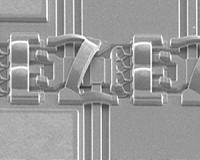 |
Washington DC (SPX) Jun 11, 2010 After running a series of complex computer simulations, researchers have found that flaws in the structure of magnetic nanoscale wires play an important role in determining the operating speed of novel devices using such nanowires to store and process information. The finding, made by researchers from the National Institute of Standards and Technology (NIST), the University of Maryland, and the University of Paris XI, will help to deepen the physical understanding and guide the interpretation of future experiments of these next-generation devices. Magnetic nanowires store information in discrete bands of magnetic spins. One can imagine the nanowire like a straw sucking up and holding the liquid of a meticulously layered chocolate and vanilla milkshake, with the chocolate segments representing 1s and the vanilla 0s. The boundaries between these layers are called domain walls. Researchers manipulate the information stored on the nanowire using an electrical current to push the domain walls, and the information they enclose, through the wire and past immobile read and write heads. Interpretations of experiments seeking to measure how domain walls move have largely ignored the effects of "disorder"-usually the result of defects or impurities in the structure of the nanowires. To see how disorder affects the motion of these microscopic magnetic domains, NIST researchers and their colleagues introduced disorder into their computer simulations. Their simulations showed that disorder, which causes friction within the nanowires, can increase the rate at which a current can move domain walls. According to NIST physicist Mark Stiles, friction can cause the domain walls to move faster because they need to lose energy in order to move down the wire. For example, when a gyroscope spins, it resists the force of gravity. If a little friction is introduced into the gyroscope's bearing, the gyroscope will fall over more quickly. Similarly, in the absence of damping, a domain wall will only move from one side of the nanowire to the other. Disorder within the nanowire enables the domain walls to lose energy, which gives them the freedom to "fall" down the length of the wire as they move back and forth. "We can say that the domain wall is moving as if it were in a system that has considerably greater effective damping than the actual damping," says NIST physicist and lead researcher Hongki Min. "This increase in the effective damping is significant enough that it should affect the interpretation of most future domain wall experiments."
Share This Article With Planet Earth
Related Links National Institute of Standards and Technology (NIST) Computer Chip Architecture, Technology and Manufacture Nano Technology News From SpaceMart.com
 Northrop Grumman Doubles Frequency Of Fastest Reported Integrated Circuit
Northrop Grumman Doubles Frequency Of Fastest Reported Integrated CircuitRedondo Beach CA (SPX) Jun 01, 2010 Northrop Grumman has set a new electronics performance record with a Terahertz Monolithic Integrated Circuit (TMIC) operating at 0.67 terahertz (THz), or 0.67 trillion cycles per second. Developed at the company's Simon Ramo Microelectronics Center under a contract with the Defense Advanced Research Projects Agency's (DARPA) Terahertz Electronics program, this new performance record more t ... read more |
|
| The content herein, unless otherwise known to be public domain, are Copyright 1995-2010 - SpaceDaily. AFP and UPI Wire Stories are copyright Agence France-Presse and United Press International. ESA Portal Reports are copyright European Space Agency. All NASA sourced material is public domain. Additional copyrights may apply in whole or part to other bona fide parties. Advertising does not imply endorsement,agreement or approval of any opinions, statements or information provided by SpaceDaily on any Web page published or hosted by SpaceDaily. Privacy Statement |